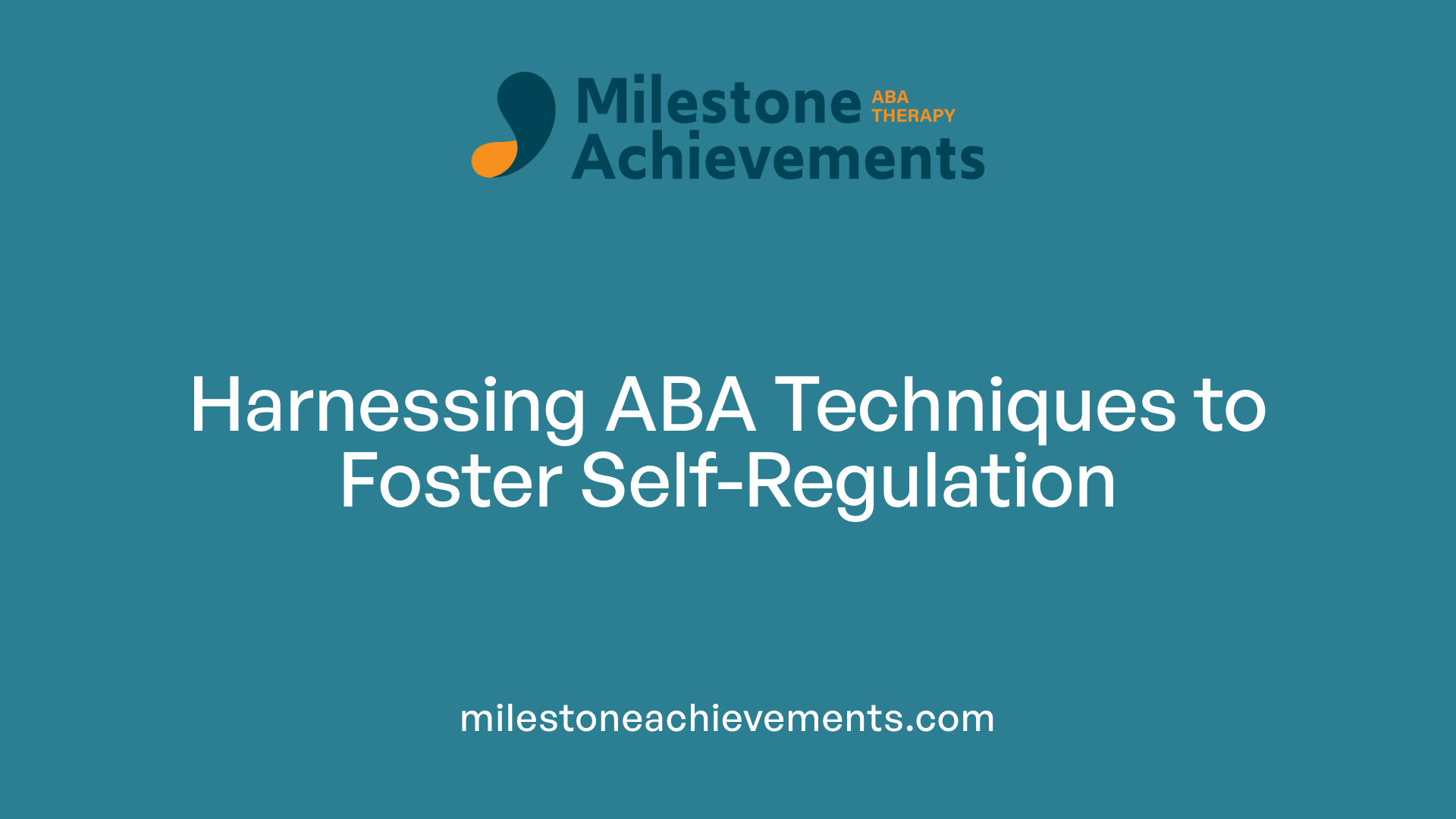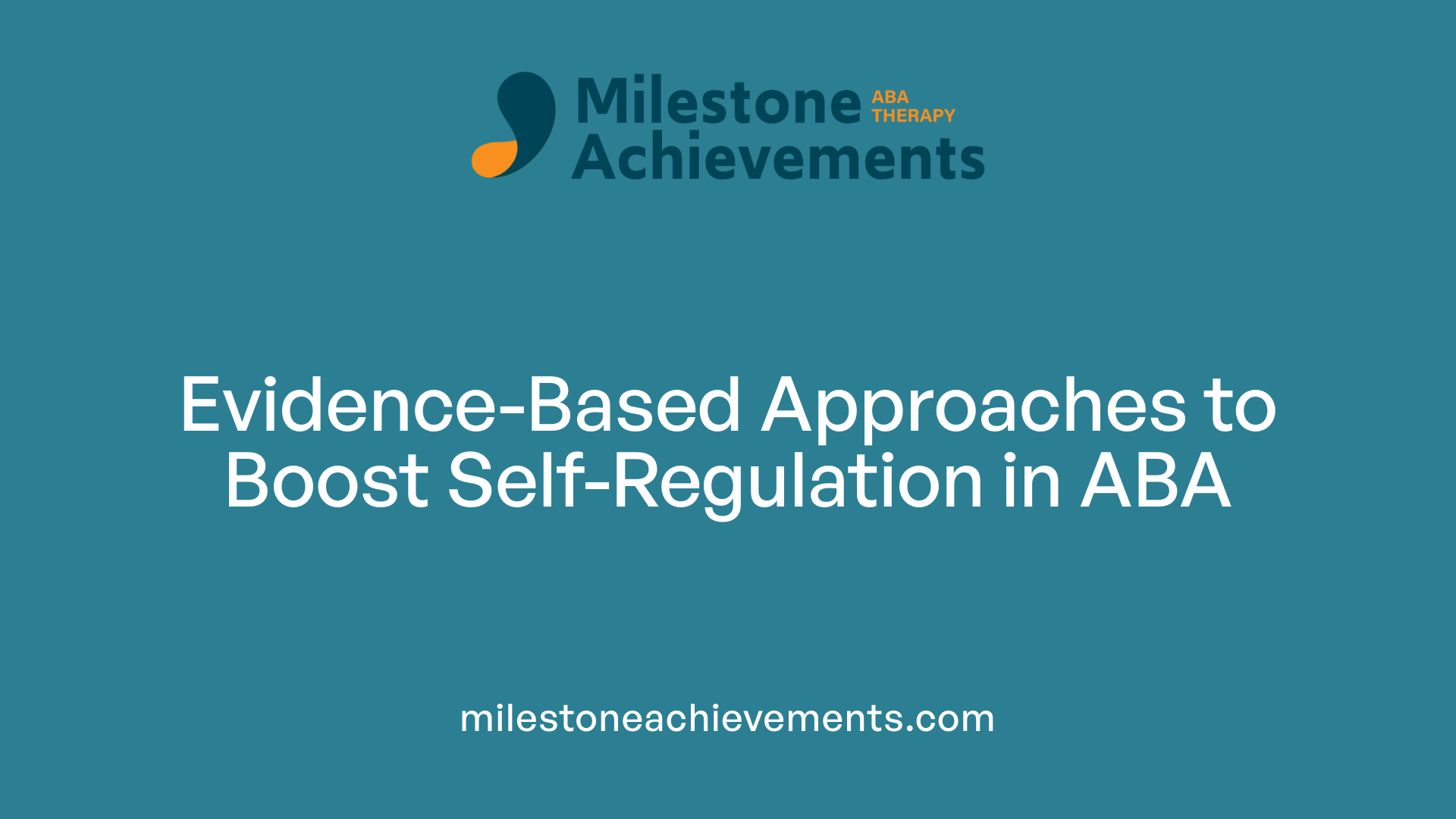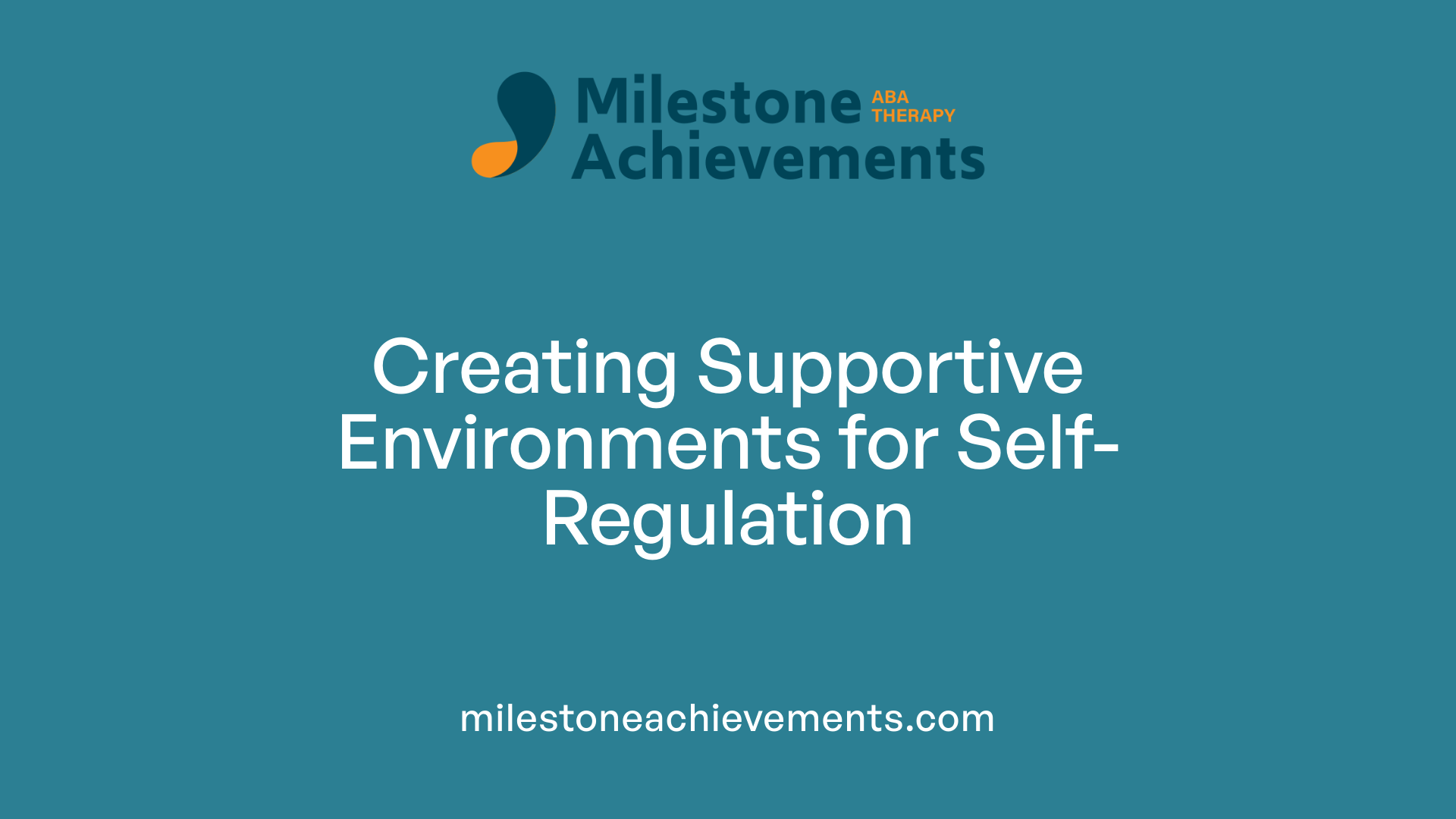Self-Regulation Strategies in ABA
Enhancing Emotional and Behavioral Skills in Autism Through Structured Interventions

Understanding Self-Regulation in Autism Spectrum Disorder
Self-regulation is a crucial aspect of development for children with autism, encompassing the ability to manage emotions, behaviors, and reactions to foster well-being and enhance social interactions. This article explores the developmental trajectory of self-regulation in children with autism, discusses evidence-based strategies within ABA, and provides practical tools for caregivers and practitioners to support emotional regulation.
Developmental Progression of Self-Regulation in Children with Autism
What is the typical development of self-regulation in children with autism?
Children with autism usually experience a gradual process in developing self-regulation skills. Early on, they start by learning to recognize and manage basic emotions through visual aids, emotion charts, and routine-based strategies. These tools help them identify what they are feeling and develop initial coping mechanisms, such as deep breathing or sensory activities.
As children grow, they begin to grasp more complex social cues and emotional signals. They learn to modulate their reactions during challenging interactions or stressful situations. This development often involves structured teaching through social stories, role-playing, and positive reinforcement strategies within therapy settings like Applied Behavior Analysis (ABA).
Over time, the focus expands from emotional awareness to controlling behaviors and engaging appropriately in social environments. Skills such as managing impulsivity, understanding others’ perspectives, and adapting reactions to different contexts become more attainable. The development of these skills depends heavily on various factors, including the child's environment, caregiver involvement, and targeted teaching methods.
Role of early intervention and ongoing support
Early intervention plays a vital role in fostering self-regulation in children with autism. Programs that include visual supports, sensory strategies, and behavioral reinforcement can significantly enhance emotional and behavioral control from a young age. Intervention strategies like routine establishment, visual schedules, and social stories help reduce anxiety and promote independence.
Support should be continuous, adaptable to the child's developing needs, and embedded within daily routines. Ongoing support from caregivers, teachers, and therapists reinforces skills learned and encourages generalization across different settings. Such consistent intervention not only boosts emotional regulation but also lays a foundation for social skills, academic success, and better overall functioning.
Factors influencing development including environment and caregiver support
The development of self-regulation is influenced by multiple factors, including the quality of the environment and the level of caregiver support. A structured, predictable environment with clear routines and sensory accommodations can help children with autism feel secure and better able to regulate their emotions.
Caregivers who actively participate by modeling calm behaviors, employing visual supports, and reinforcing positive coping strategies significantly impact development. Providing consistent, responsive interaction helps children learn effective emotional management and builds their trust and confidence.
In addition, external factors such as sensory sensitivities, neurobiological differences, and language skills play roles in shaping self-regulation. Tailoring environments and interventions to meet individual needs ensures more meaningful progress.
| Factors | Impact on Self-Regulation | Recommendations |
|---|---|---|
| Environment | Stability and sensory adaptations reduce overwhelm | Use of quiet spaces, noise reduction tools |
| Caregiver Support | Reinforcement and modeling build skills | Consistent routines, emotional coaching |
| Child’s Developmental Level | Influences the complexity of skills learned | Age-appropriate, personalized strategies |
| Intervention Quality | Determines effectiveness of skill acquisition | Evidence-based programs, trained professionals |
Understanding these dynamics helps create comprehensive support plans. Ultimately, fostering self-regulation in children with autism enhances their ability to participate socially, achieve independence, and enjoy a higher quality of life.
The Role of ABA in Developing Self-Regulation Skills
 ABA, or Applied Behavior Analysis, utilizes systematic teaching methods to foster self-regulation skills in individuals, especially children with autism spectrum disorder (ASD). It focuses on breaking down complex emotional and behavioral skills into manageable steps, making learning efficient and targeted.
ABA, or Applied Behavior Analysis, utilizes systematic teaching methods to foster self-regulation skills in individuals, especially children with autism spectrum disorder (ASD). It focuses on breaking down complex emotional and behavioral skills into manageable steps, making learning efficient and targeted.
One of the core strategies involves reinforcement—using praise, rewards, and positive feedback to encourage desirable behaviors. Prompting and modeling are also vital; caregivers and therapists demonstrate coping and regulation techniques, such as deep breathing or calm responses, which children can imitate.
Shaping behaviors through gradual reinforcement helps learners progress from simple to more complex self-regulation skills. For example, initially rewarding a child for recognizing their emotions, then for requesting a break, and eventually for managing their feelings in challenging situations.
Structured and individualized interventions are essential. Each plan is tailored to the child's specific needs, incorporating visual supports like emotion charts, social stories, and visual schedules. These tools assist children in recognizing emotions early and implementing calming strategies proactively.
Progress monitoring through data collection ensures that interventions remain effective and adaptable. This continuous feedback allows therapists to refine strategies, emphasizing success in real-world settings.
Overall, ABA's focus on evidence-based techniques, reinforcement, prompting, modeling, and tailored interventions make it a potent approach to helping individuals develop essential self-management skills. Such skills not only improve emotional control but also support social interactions and promote independence across various environments.
Principles of ABA Supporting Self-Regulation Education
How do principles of Applied Behavior Analysis relate to teaching self-regulation skills?
Applied Behavior Analysis (ABA) offers a structured approach to teaching self-regulation by shaping behaviors through environmental strategies. Core ABA concepts like reinforcement, prompting, and shaping are central to fostering self-control and emotional management.
Reinforcement is used to encourage desirable self-regulation behaviors, such as calming techniques or use of coping strategies. Prompts—visual cues, cues for specific actions, or verbal hints—help guide children through calming routines or emotional recognition tasks. As skills develop, prompts are gradually faded to promote independence.
Shaping involves breaking down complex emotional regulation skills, like managing frustration, into smaller steps and reinforcing each successful attempt. Functional behavior assessments identify specific triggers that cause dysregulation, allowing interventions to be customized and more effective.
Techniques such as self-monitoring utilize visual supports or digital tools to increase awareness of emotional states and behaviors. Goal setting, combined with consistent reinforcement, helps children learn to manage impulses, recognize emotions early, and respond adaptively.
Overall, ABA principles create a predictable learning environment where children gain skills gradually. The focus on positive reinforcement motivates children to practice self-regulation strategies, leading to better emotional management and social interactions.
This evidence-based framework not only improves current behaviors but also encourages long-term independence in managing emotions, vital for functioning across various settings and situations.
Research-Based Techniques for Enhancing Self-Regulation within ABA

What are evidence-based techniques for improving self-regulation within Applied Behavior Analysis (ABA)?
Implementing effective self-regulation strategies in ABA involves a combination of proven techniques aimed at fostering emotional and behavioral control. One foundational approach is the consistent use of positive reinforcement and token economies, which motivate individuals to engage in self-regulatory behaviors by rewarding progress with praise or tangible rewards.
Visual supports are also integral to these strategies. Tools such as emotion charts, social stories, and visual schedules assist children in recognizing emotional cues and planning appropriate responses. These visual aids simplify complex concepts and provide clear expectations, reducing anxiety and promoting self-awareness.
Sensory strategies further support regulation, especially for children with sensory sensitivities. Sensory-friendly breaks, weighted items like vests or blankets, and modifications to the environment help maintain sensory equilibrium.
Mindfulness exercises, including deep breathing, guided imagery, and body scans, are incorporated to enhance emotional awareness and promote calmness during moments of dysregulation.
ABA interventions also emphasize techniques like prompt fading, modeling, and role-playing to teach and reinforce self-regulation skills. Using gradual shaping, children learn to manage their reactions in increasingly challenging situations.
Structured routines and self-management plans play a significant role too. These include setting measurable goals, self-monitoring with checklists or digital apps, and continuous reinforcement, which encourage independence and consistency across various settings. Together, these evidence-based components form a comprehensive approach to developing robust self-regulation skills in individuals receiving ABA therapy.
Tools and Methods for Teaching Emotional Regulation in ABA
What practical tools and methods are used in ABA to teach emotional regulation?
Applied Behavior Analysis (ABA) employs a variety of accessible and effective strategies to nurture emotional regulation skills. Visual aids are fundamental; these include emotion cards depicting different feelings, the Zones of Regulation system with color-coded zones to classify emotional states, as well as social stories and video modeling that illustrate calm behavior and coping techniques in relatable scenarios. These tools help children identify emotions early and choose appropriate responses.
Role-playing and modeling are also crucial. Through role-playing, children practice handling real-life situations safely, while modeling by caregivers or therapists demonstrates how to manage emotions appropriately. Discrete Trial Training (DTT) offers structured teaching sessions that break down emotional regulation steps into manageable parts, enhancing skill acquisition.
Behavior Skills Training (BST) combines instruction, demonstration, rehearsal, and feedback to teach calming strategies and emotional awareness effectively. During training, children learn to recognize their feelings, employ techniques like deep breathing or requesting breaks, and reinforce these behaviors through praise or rewards. Regular data collection on a child’s progress allows therapists to tailor interventions, ensuring skills are reinforced across different settings and situations.
Overall, these tools and methods form a comprehensive approach within ABA to foster emotional understanding and regulation, leading to more adaptive behaviors and improved social interaction.
Strategies to Foster Emotional Regulation and Promote Independence
What strategies can help foster emotional regulation and independence in individuals with autism?
Supporting individuals with autism in developing emotional regulation and independence involves a variety of tailored strategies. Visual supports, such as picture schedules, emotion charts, and social stories, help create predictable routines and aid in understanding expectations, thereby reducing anxiety and confusion.
Structured routines and predictable environments are crucial. Consistent daily activities and environmental organization provide stability, making it easier for individuals to anticipate and adapt to their surroundings.
Teaching functional communication skills is also essential. Techniques such as sign language, speech, or alternative augmentative communication (AAC) devices empower individuals to express their needs, frustrations, or emotions effectively, thus preventing meltdown triggers.
Sensory strategies, including the use of sensory tools like weighted blankets or noise-canceling headphones, along with mindfulness activities and coping tools, help manage sensory sensitivities and emotional overwhelm.
Additionally, social skills training through role-playing, social stories, and guided problem-solving activities fosters adaptive behaviors, enhancing social interaction and independence in daily tasks.
Collaboration with families and caregivers is vital. Implementing positive reinforcement strategies, providing consistent feedback, and gradually reducing the level of support promote long-term skill development.
Overall, combining these methods creates a supportive environment that nurtures emotional resilience and builds greater independence tailored to each person's unique needs.
Applied Strategies and Environments Facilitating Self-Regulation

What practical tools and methods are used in ABA to teach emotional regulation?
In ABA therapy, a variety of practical tools and approaches are employed to foster emotional regulation skills. Visual supports are central, including emotion cards, color-coded systems like the Zones of Regulation, stoplight visuals, and icons. These tools help children identify and understand their feelings and guide them toward suitable regulation strategies.
Modeling and labeling emotions in natural settings further reinforce recognition and management of emotions. Role-playing activities allow children to practice handling different emotional situations in a safe environment. Discrete trial teaching structures learning sessions, providing clear instruction and reinforcement.
Behavior Skills Training (BST) is also widely used. This involves teaching through a combination of instruction, demonstration, rehearsal, and feedback. Children learn calming techniques and coping strategies effectively when supported by consistent practice and positive reinforcement.
Data collection on progress and the ability to generalize skills across settings are core to ABA methods, ensuring that emotional regulation improves over time and applies in everyday life.
Use of visual supports like schedules and checklists
Visual tools like daily schedules and checklists help children anticipate upcoming activities, reducing anxiety and promoting self-management. These supports provide clear, visual cues about routines and expectations, which is especially beneficial for children with autism.
Self-monitoring tools like digital apps
Digital applications and checklists enable children and caregivers to track emotional states and regulation attempts. These tools enhance awareness of triggers and successful regulation strategies, fostering independent self-monitoring.
Environmental modifications such as noise-canceling headphones
Adjusting the environment to reduce sensory overload can prevent emotional dysregulation. Noise-canceling headphones or creating quiet spaces serve as effective sensory modifications, helping children manage sensory sensitivities and stay calm.
| Tool/Method | Purpose | Additional Details |
|---|---|---|
| Visual Supports (e.g., emotion cards, schedules) | Recognize emotions, structure routines | Widely used for teaching and generalization |
| Self-monitoring Digital Apps | Track emotional cues and regulation attempts | Promotes independence and data-driven adjustments |
| Environmental Modifications (e.g., noise-canceling headphones) | Reduce sensory triggers and prevent overwhelm | Important for sensory regulation |
These strategies, when combined, create a supportive environment that promotes emotional awareness and effective regulation in children with autism, leading to better social interactions and daily functioning.
Monitoring Progress and Ethical Considerations in Self-Regulation Interventions

How do principles of Applied Behavior Analysis relate to teaching self-regulation skills?
Applied Behavior Analysis (ABA) offers a structured approach to teaching self-regulation skills, emphasizing the importance of observable behaviors and environmental influences. Through techniques like reinforcement, prompting, fading prompts, and task analysis, ABA helps shape adaptive behaviors and reduce maladaptive responses.
Functional behavior assessments play a critical role in identifying specific triggers and environmental factors that impact a child's behavior. This allows practitioners to design personalized interventions that promote self-control, emotional management, and adaptive responses.
Key ABA strategies include self-monitoring tools, goal setting, and reinforcement systems. For example, visual schedules and checklists help children recognize when to employ coping strategies or self-regulate, while positive reinforcement encourages consistent use of these skills.
Through consistent application of ABA methods, individuals learn to manage impulses, pay attention, and regulate emotions effectively. Overall, ABA offers an evidence-based framework that supports skill development in self-regulation, aiming for increased independence and improved daily functioning.
Use of data collection and progress tracking options
Tracking progress is essential in ensuring the effectiveness of self-regulation interventions, particularly within ABA frameworks. Data collection methods include frequency counts, duration measures, and checklist records to monitor behaviors and emotional responses over time.
Progress tracking tools such as charts, digital apps, and automated platforms offer visual and quantitative data that help practitioners and caregivers assess improvements. These tools facilitate the identification of patterns, triggers, and skill generalization across different environments.
Long-term monitoring supports adjustments in intervention strategies, ensuring goals remain relevant and attainable. Advances in technology, like AI-assisted data analysis, enhance the efficiency and accuracy of tracking, allowing for real-time adjustments and more personalized interventions.
Implementing regular progress reviews boosts motivation, helps maintain consistency, and fosters greater independence for individuals with autism by providing clear evidence of their growth.
Ethical considerations in self-regulation support
Effective self-regulation interventions must prioritize individualization, cultural sensitivity, and the promotion of positive behaviors without punishment. Interventions should always align with the individual’s needs, preferences, and developmental level.
Respecting autonomy and dignity involves employing reinforcement strategies rather than punitive measures. Caregivers and practitioners must ensure that interventions are ethically sound, promoting skill-building while avoiding trauma or frustration.
Transparency with families and respecting cultural differences enhance the acceptance and effectiveness of interventions. Ongoing assessment and collaboration help tailor strategies that are respectful, effective, and sustainable.
By adhering to ethical principles, practitioners can foster positive behavioral change that benefits the individual’s well-being and quality of life.
Long-term Benefits of Implementing Self-Regulation Strategies in Autism
 When effective self-regulation strategies are integrated into daily routines and interventions for children with autism, they can significantly transform long-term outcomes. One notable benefit is the improvement in daily functioning and social interactions. As children learn to recognize, understand, and manage their emotions, they become more capable of engaging positively with peers, family members, and teachers. This results in smoother social exchanges and enhanced relationship-building skills.
When effective self-regulation strategies are integrated into daily routines and interventions for children with autism, they can significantly transform long-term outcomes. One notable benefit is the improvement in daily functioning and social interactions. As children learn to recognize, understand, and manage their emotions, they become more capable of engaging positively with peers, family members, and teachers. This results in smoother social exchanges and enhanced relationship-building skills.
Moreover, implementing these strategies often leads to reduced stress for caregivers. With tools like visual schedules, self-monitoring aids, and consistent reinforcement, caregivers experience less frustration and are better equipped to support their child's growth. This supportive environment fosters a higher quality of life for the entire family, characterized by greater patience, understanding, and cooperation.
Another advantage is the potential for skill generalization and maintenance over time. Skills learned through structured interventions—such as emotional awareness, coping techniques, and self-management—are more likely to be applied across different settings and situations. This consistency helps to preserve progress, allowing children to adapt their self-regulation in varied contexts, including school and social settings.
Overall, teaching and reinforcing self-regulation in children with autism yields enduring benefits—improving functional independence, facilitating social inclusion, alleviating caregiver stress, and supporting a more fulfilling, balanced life for individuals on the spectrum.
Supporting Autism Spectrum Disorder Through Self-Regulation Strategies
Implementing evidence-based self-regulation strategies within ABA provides children with autism the tools to better manage their emotions and behaviors, fostering greater independence and social participation. The structured and individualized approaches, emphasizing visual supports, reinforcement, and caregiver collaboration, lead to meaningful progress across developmental domains. Continued research and practice improvements will further enhance the effectiveness of these interventions, ultimately contributing to improved life quality and developmental outcomes for individuals with autism.
References
- How to Support Self-Regulation in Children with Autism - AutismCOE
- Emotion Regulation: Concepts & Practice in Autism Spectrum Disorder
- Teaching Children to Self-Regulate Their Emotions - ABA Therapy
- [PDF] Emotional Regulation Strategies
- 7 Essential Self Management Strategies for ABA Therapy Success
- Teaching Emotional Regulation with ABA Tools
- How to Improve Emotional Self-Regulation Among Children with ...
- Self-regulation predicts companionship in children with autism - PMC







